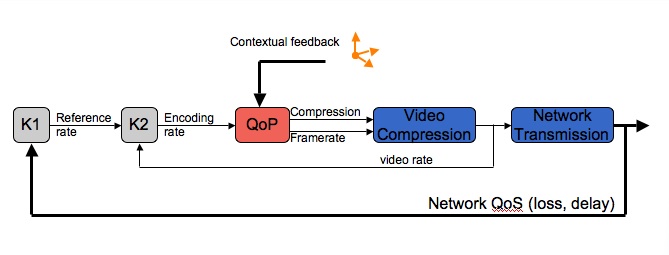Damien Perritaz, Christophe Salzmann, Denis Gillet
Overview
ransmission of video over wireless network is used in many applications. In order to respect network bandwidth constraints, the video must be compressed for size reduction. In real-time interactive applications, low delay and high quality video are required for user satisfaction. The challenge is to find the compromise between a high compression resulting in a small size but poor quality and a low compression resulting in a rich quality but big size inducing higher delay in transmission. An adaptation scheme is proposed to manage the video compression in real-time, according to dynamical network characteristics and user context. Based on models for user perception, video compression and network compression an adaptation scheme using contextual feedback aims at maximizing user satisfaction according to network and video characteristics.
Adaptation scheme, video compression, user perception, wireless network
User perception
The Quality of Perception (QoP) is defined as the measure of user satisfaction. Using experimental subjective testing, the user Quality of Perception (QoP) for video sequences is modeled to continuously determine the best encoding parameters values resulting from the compromise between the fluidity and the level of detail in the context of real-time interactive video.
Video adaptation
Due to the encoder characteristics, the output bit rate of an encoded video stream depends on its content, for example an image with many details will carry a bigger size than a uniformly black image. Similarly, a sequence with rapid changes in its content will be bigger in size than an almost static video sequence. As a consequence, a stream adaptation scheme must be deployed in order to follow the given sending rate reference. The proposed approach implements a controller-based video compression that adapts both the sending frame rate and the image compression factor.
Network adaptation
The communication link has a limited capacity that varies through time; it is dependent on many factors such as the number of users and the distance between the sender and the receiver. Sent data exceeding the available bandwidth will be delayed and lost by the network. Network adaptation mechanism must be deployed to keep the sending rate in accordance with available bandwidth. A sender-based rate adjustment mechanism is continuously used to minimize the QoP decrease due to these transmission losses. Real measurements on a wireless transmission link have been used to identify the behavior of the sending rate on the transmission delay and loss: for a given network configuration and conditions, an adequate sending rate exists to limit loss and delay. This sending rate can be obtained using a controller tracking a reference transmission delay.

Keywords : Interaction; Quality of perception; Adaptation; network;
Related publications
[epfl_infoscience url=”https://infoscience.epfl.ch/publication-exports/2831/”]